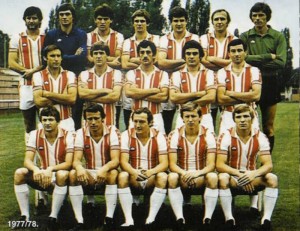Portugal attracted little international interest in the second half of the 1970s, almost a forgotten country , mentioned more for historic reasons than actual ones. A question about second division would have puzzled many – generally, people hardly even knew who played in the top league. As for the second level, there was not one, but three second division leagues – Northern, Central, and Southern. Each league 16-team strong, the bottom four relegated further down. As for promotion, it was complicated: 4 teams were going up. The champions, naturally, and the 4th? The 4th promotion went to winner of the play-off mini-league of the three 2nd placed clubs. Almost all clubs meant nothing outside Portugal and quite little in there own country: fading for years clubs, like CUF; various up and down ‘unsettled’ ones, like Penafiel; and those who never even dreamed of top flight, like Odivelas. This particular season should be noted for two famous players kicking the ball down there:
 Standing from left: Eusébio, Florival, Barrinha, Marito, Varela, Sarmento, Vieirinha
Standing from left: Eusébio, Florival, Barrinha, Marito, Varela, Sarmento, Vieirinha
Crouching: Graça, Alcino, Mário Pinto, Simões (cap.), Faustino.
Eusebio and his former teammate in the great Benfica Simoes now played with the black shirts of Uniao Tomar. Their presence helped the club to finish 4th in the II Divisao Centro. For Eusebio this was his last season in Portugal – he retired one year later, but in USA. Simoes had a few more years to go.
So much for fame. Almost. There was one more fairly famous player – the much traveled Hungarian defector Antal Nagy. He played for Leixoes this season, arriving from spell in Belgium. Almost forgotten in his twilight years.
 Leixoes: standing from left: Adriano, José Manuel, Lucio, Josefá, Sá, Nagy
Leixoes: standing from left: Adriano, José Manuel, Lucio, Josefá, Sá, Nagy
First row: Marcos, Bené, Festas, Frasco, Jacinto.
Of course, there were many foreigners in the second division clubs, but they were Brazilians and Africans from the former colonies. Some players from Mozambique were white. None was known and almost none was a proper import – they were considered domestic, with possible exception of one Uruguayan and Mady Keita from Mali. Well, big names don’t play second division football, but to outsiders there were obvious discrepancies – Academico Viseu had 7 foreign players, some clubs had the normal for the 1970s two, and many a club did not have any. Well, Academico Viseu had only one player who may have been ‘proper import’ – the already mentioned Mady Keita. The rest were practically domestic, coming from former colonies. However, the large number seemingly helped the club.
As the championship went, the drama was mostly concentrated in the lower league regions, where clubs were preoccupied with survival. On the top it was calm… all champions were solitary leaders without opposition. Barreirense won Divisao Sul by 4 points.
 Standing from left: Abrantes, Campora, Serra, Cunha, Páscoa, José João, Nelinho, Loia, Romão, Pavão.
Standing from left: Abrantes, Campora, Serra, Cunha, Páscoa, José João, Nelinho, Loia, Romão, Pavão.
First row : Arnaldo, Andrade, Alexandre, Piloto, Coentro Faria, Cansado.
The Uruguayan veteran Henrique Campora, playing in Portugal since 1971, one Brazilian – Indio – and a player from Cape Verde – Joao Cabral – in the squad.
Beira Mar did better in Divisao Centro – they left the nearest pursuer 6 points behind.
 Standing from left : Quaresma, Jesus, Manecas, Abel, João Poeira, Sabu.
Standing from left : Quaresma, Jesus, Manecas, Abel, João Poeira, Sabu.
Crouching: Cambraia, Sousa, Sobral, Germano, Nelson Reis.
Three ‘almost foreigners’ helped Beira Mar to win the championship – Lima (Brazil), Simao (Cape Verde), and Joao Sabu (Angola).
This was still nothing compared to the dominance of Famalicao in Divisao Norte – they were 14 points ahead of the 2nd placed Aliados Lordelo. Their goal-difference was fantastic – plus 51 goals compared to measly plus 3 of Aliados Lordelo.
 Standing from left: Nando, Branco, Djair, Duarte, Amadeu, Zézinho.
Standing from left: Nando, Branco, Djair, Duarte, Amadeu, Zézinho.
First row : Reinaldo, Jacques, Vitor Oliveira, Sá Pereira, Lula.
Famalicao had two Brazilians in the squad – the goalkeeper Djair and Lula.
The second-placed in the three leagues competed for the 4th promotion – 2-legged round-robin tournament. Curiously – or may be not – it was won by the best second placed team in the regular season – Academico Viseu finsished it with 41 points. Juventude Evora had the same points, but worse goal-difference. In the mini-league a single tie decided first and second places – Academico Viseu extracted a point from Aliados Lordelo, thus finishing with 5 points. Juventude got 4 points and Aliados 3.
 Academico – or CAF – from Viseu went up in the last minute. Only one thing can be said about them – perhaps they were the team with most foreign players in the Second Division: 7. The names mean nothing, but let name them anyway: Francisco Gomes (Brazil), Pedro Paulo (Brazil), Renato (Brazil), Segio Albasini (Mozambique), Toyobe (Mozambique), Jose Penteado (Angola), and Mady Keita (Mali).
Academico – or CAF – from Viseu went up in the last minute. Only one thing can be said about them – perhaps they were the team with most foreign players in the Second Division: 7. The names mean nothing, but let name them anyway: Francisco Gomes (Brazil), Pedro Paulo (Brazil), Renato (Brazil), Segio Albasini (Mozambique), Toyobe (Mozambique), Jose Penteado (Angola), and Mady Keita (Mali).
Good for the winners, joy everywhere, but none of the promoted was to be a big news next year… most likely they were to fight for survival.
































































